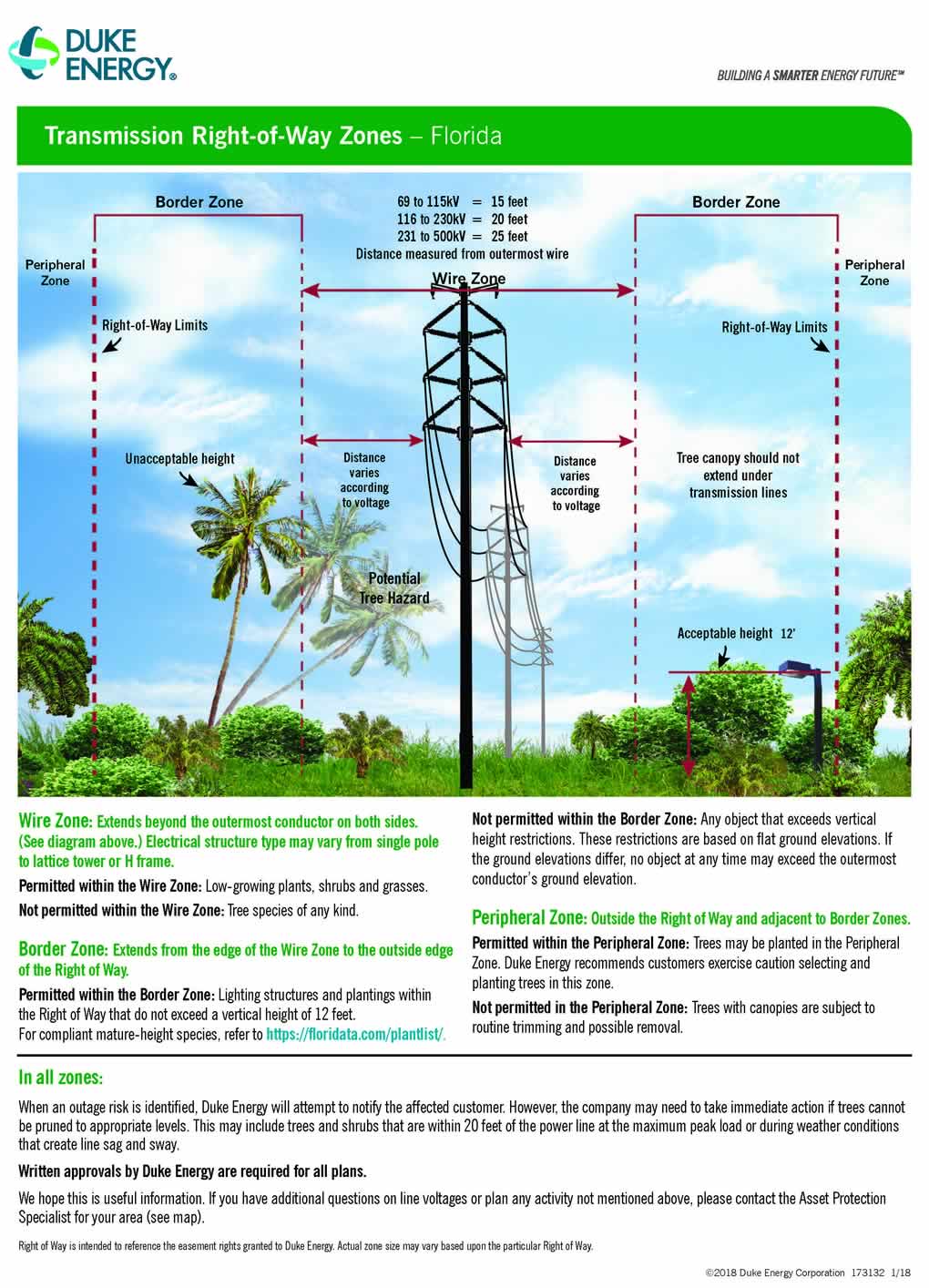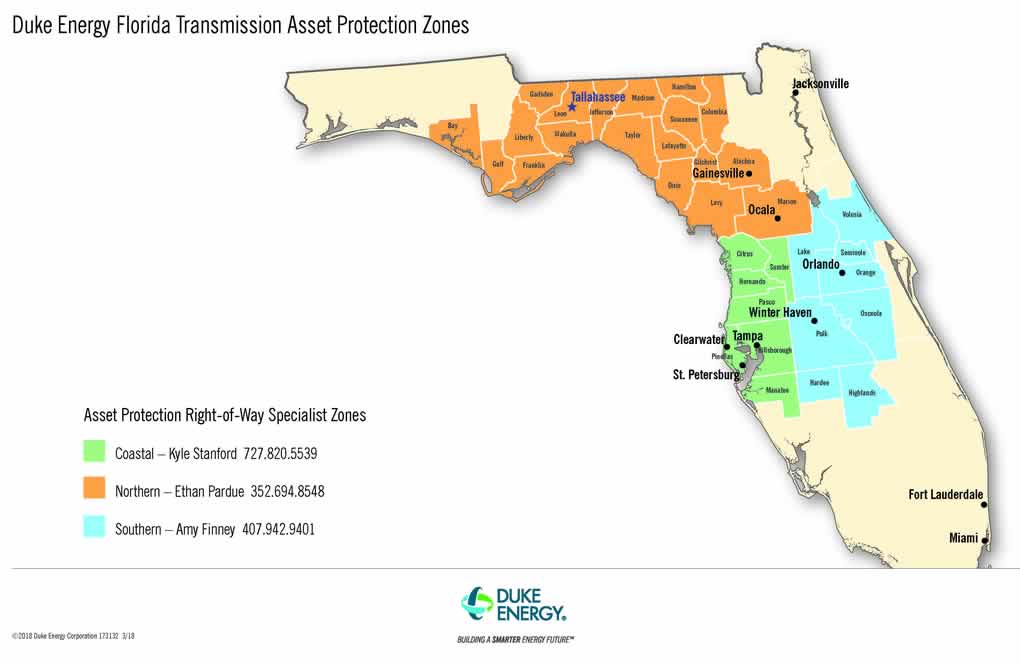Duke Energy owns and operates an extensive network of 3,600 miles of transmission line rights of way and over 200 miles of abandoned railroad rights of way in 32 northern and central Florida counties. These rights of way serve as energy interconnects to safely and efficiently transmit high voltage electricity from generators to consumers. Duke Energy’s goal is to provide safe, reliable and economical electrical service to all customers. Keeping electricity reliable requires unobstructed access for maintaining power lines, facilities and rights-of-way. The following list has been developed to provide landowners and other interested parties with a guide for the use of Duke Energy’s transmission line rights-of-way. If you wish to use a Duke Energy transmission right-of-way, please contact a Duke Energy Asset Protection Right-of-Way Specialist concerning any proposed plans (see map below).
Duke Energy receives many requests from landowners, adjoining property owners, community leaders and governmental agencies to encroach upon power line rights of way. An encroachment is any use or activity within the transmission right of way that restricts, in any way, the full use or purpose for which the right of way was established. An encroachment includes, but is not limited to, any structure, building, facility improvement, fill, excavation, vegetation, material storage, equipment, obstruction, etc. Encroachments restrict Duke Energy 's access to its electrical facilities for maintenance and power restoration. The Transmission Right of Way Use Program oversees Duke Energy 's vested interest in transmission and distribution line rights of way to make sure reliability, engineering, access and safety standards are maintained.
Duke Energy does not guarantee your requested use to be completely compatible with the safe and efficient operation and maintenance of Duke Energy’s existing and future high voltage electrical lines. Any remedial action required to resolve a subsequent conflict will be at your sole cost and expense.
Duke Energy transmission rights-of-way contain high voltage power lines. Extreme caution must be used when working in the right-of-way.
ELECTRIC TRANSMISSION RIGHT-OF-WAY GUIDELINES/RESTRICTIONS
VALID FOR FLORIDA (Revised 12/05/17)
This list of right-of-way restrictions has been developed to answer the most frequently asked questions about property owner use of Duke Energy’s electric transmission rights of way. This list does not cover all restrictions or all possible situations. You should contact the Asset Protection right-of-way specialist if you have additional concerns about the rights of way. This list of restrictions is subject to change at any time and without notice. Duke Energy reserves all rights conveyed to it by the right-of-way agreement applicable to the subject property. All activity within the rights of way shall be reviewed by an Asset Protection right-of-way specialist to obtain prior written approval. Engineering plans may be required. Compliance with the Duke Energy Right-of-Way Guidelines/Restrictions or approval of any plans by Duke Energy does not mean that the requirements of any local, county, state or federal government or other applicable agency with governing authority have been satisfied.
- Structures, buildings, manufactured/mobile homes, satellite systems, swimming pools (and any associated equipment and decking), graves, billboards, dumpsters, signs, wells, deer stands, retaining walls, septic systems or tanks (whether above or below ground), debris of any type, flammable material, building material, wrecked or disabled vehicles and all other objects (whether above or below ground) which in Duke Energy’s opinion interfere with the electric transmission right of way are not allowed within the right-of-way limits. Transformers, telephone/cable pedestals (and associated equipment) and fire hydrants are not allowed. Manholes, water valves, water meters, backflow preventers and irrigation heads are not permitted. Attachments to Duke Energy structures are prohibited.
- Fences and gates shall not exceed 10 feet in height and shall be installed greater than 25 feet from poles, towers and guy anchors. Fences shall not parallel the centerline within the rights of way but may cross from one side to the other at any angle not less than 30 degrees with the centerline. If a fence crosses the right of way, a gate (16 feet wide at each crossing) shall be installed by the property owner, per Duke Energy’s specifications. The property owner is required to install a Duke Energy lock on the gate to ensure access. Duke Energy will supply a lock.
- Grading (cuts or fill) shall be no closer than 25 feet from poles, towers, guys and anchors (except for parking areas; see paragraph 7) and the slope shall not exceed 4:1. Grading or filling near Duke Energy facilities which will prevent free equipment access or create ground-to-conductor clearance violations will not be permitted. Storage or stockpiling of dirt or any other material is prohibited. Sedimentation control, including re-vegetation, is required per state regulations.
- Streets, roads, driveways, sewer/water lines, other utility lines or any underground facilities shall not parallel the centerline within the right of way but may cross, from one side to the other, at any angle not less than 30 degrees with the centerline. No portion of such facility or corresponding easement shall be located within 25 feet of Duke Energy’s facilities. Roundabouts, cul-de-sacs and intersections (such as roads, driveways and alleyways) are not permitted.
- Any drainage feature that causes erosion, directs storm water toward the rights of way, or limits access to or around Duke Energy facilities is prohibited.
- Lakes, ponds, retention or detention facilities, etc. are restricted and must be approved by Duke Energy prior to construction.
- Parking may be permitted within the right of way, provided that:
- Prior to grading, concrete barriers shall be installed at a minimum of 9 feet from the Duke Energy facilities. During construction, grading shall be no closer than 10 feet to any Duke Energy facility.
- After grading/paving activity is complete, a Duke Energy-approved barrier sufficient to withstand a 15 mph vehicular impact
- shall be installed 9 feet from any Duke Energy facility.
- Any access areas, entrances or exits shall cross (from one side to the other) the right of way at any angle not less than 30 degrees with the centerline and shall not pass within 25 feet of any structure. Parking lot entrances/exits cannot create an intersection within the right of way.
- Lighting within the right-of-way limits must be approved by Duke Energy before installing. Due to engineering design standards, lighting is not allowed in the “Wire Zone.” Where lighting is approved (Border Zone), the total height may not exceed 12 feet. Contact your Asset Protection right-of-way specialist as wire zones vary for the different lines.
- Duke Energy will not object to certain vegetation plantings as long as:
- It does not interfere with the access to or the safe, reliable operation and maintenance of Duke Energy facilities.
- With prior written approval, Duke Energy does not object to low-growing shrubs and grasses within the “Wire Zone.” Tree species are not allowed within the “Wire Zone.” Trees that are approved in the “Border Zone” may not exceed, at maturity, 12 feet. Contact the Asset Protection Specialist for Wire Zone/Border Zone definitions.
- For compliant mature height species, refer to https://floridata.com/plantlist/ for reference.
- Engineering drawings must indicate the outermost conductor.
- Vegetation that is not in compliance is subject to removal without notice.
- Duke Energy may exercise the rights to cut “danger trees” outside the right-of-way limits as required to properly maintain and operate the transmission line.
We hope this is useful information. If you have additional questions or plan any activity not mentioned above, please contact the Asset Protection Right-of-Way Specialist for your area (see map below).

